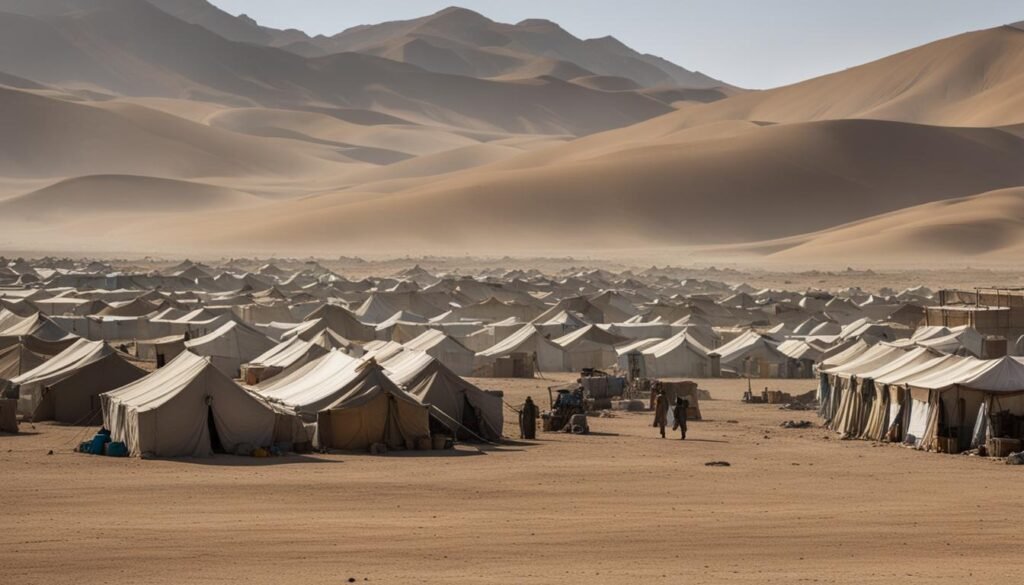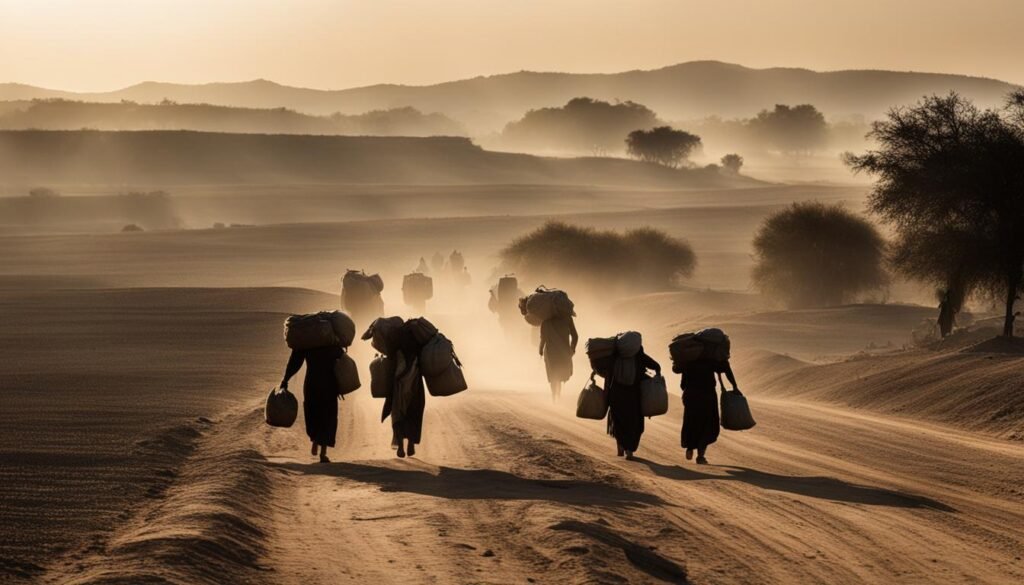In the 1930s, a significant migration of workers took place in the United States. This relocation was driven by a complex blend of economic and ecological factors that created challenging circumstances for many individuals and families. One of the key events that greatly impacted this period was the Dust Bowl, a series of severe dust storms and droughts that devastated agricultural lands in the central and southern parts of the country. As a result, many farmers were forced to leave their homes and seek new opportunities elsewhere.
California, with its mild climate and diverse crops, became a prominent destination for these migrant workers. However, their journey was marked by economic hardships, low wages, and subpar living conditions. Migrant workers faced numerous challenges as they traveled from farm to farm, following the harvest season and living in temporary camps. Despite the hardships experienced, government programs such as the Farm Security Administration (FSA) established camps to provide relief and support to these migrant workers.
Their journey was not without struggles, but the legacy of the migrant workers in the 1930s continues to shape discussions on labor conditions, economic hardship, and the rights of migrant workers to this day.
Key Takeaways:
- The Great Depression and the Dust Bowl significantly impacted the lives of migrant workers in the 1930s.
- California was a promising destination for migrant workers due to its mild climate and diverse crops.
- Migrant workers faced economic hardships, low wages, and poor living conditions during this period.
- The Farm Security Administration (FSA) established camps to provide relief and support to migrant workers.
- The migration of workers in the 1930s continues to influence discussions surrounding labor conditions and the rights of migrant workers.
Causes of Migration and Impact of the Dust Bowl
In the 1930s, a perfect storm of economic and ecological factors led to the significant migration of workers, particularly from the Great Plains to California. The Great Depression, characterized by a severe economic downturn, coupled with the Dust Bowl, a period of extreme drought and intense dust storms, had a profound impact on the lives of many Americans.
During the Great Depression, the stock market crash of 1929 and subsequent recession resulted in widespread unemployment and economic hardship. Many farmers, already struggling due to overextension and a decrease in demand for agricultural products, lost their farms and livelihoods. In search of new opportunities, these farmers and their families became migrant workers, seeking employment and a better life in California.
The Dust Bowl, a natural disaster caused by drought and dust storms, further exacerbated the economic and ecological challenges facing farmers. The combination of drought conditions and poor soil conservation practices led to the destruction of crops and fertile land, making farming impossible. The resulting dust storms devastated communities, driving thousands of farmers and their families to abandon their homes and seek refuge in other states, particularly California.
The impact of the Dust Bowl on agricultural labor was immense. The loss of farms and the displacement of farmers led to a substantial increase in the number of migrant workers. These workers, uprooted from their homes and livelihoods, traveled to California, drawn by the promise of work and better living conditions.
Although the Dust Bowl was primarily an ecological event, its effects were felt throughout the social and economic fabric of the affected areas. The displacement of farmers and the subsequent arrival of large numbers of migrant workers strained resources and created new challenges for communities already struggling with the effects of the Great Depression.
The migration of workers during this time was driven by a combination of economic and ecological factors. The economic hardships brought on by the Great Depression and the devastation caused by the Dust Bowl forced many individuals and families to make the difficult decision to leave their homes in search of new opportunities. California, with its mild climate and diverse crops, became the prime destination for these migrant workers.
Living Conditions and Challenges Faced by Migrant Workers
Migrant workers of the 1930s faced numerous challenges and endured difficult living conditions. Many of these workers lived in camps and temporary settlements with inadequate facilities and sanitation, which contributed to public health problems. The dire living conditions often exacerbated the already challenging circumstances they faced.
One of the main struggles for migrant workers was finding steady employment. They were often hired on a temporary basis, offering little job security and leaving them vulnerable to exploitation. Additionally, their wages were low, making it challenging to support themselves and their families.
The labor movement among migrant workers emerged as a response to these hardships. The movement aimed to advocate for better working and living conditions, with the goal of attaining fair wages and improved rights for migrant workers. This movement played a crucial role in raising awareness about the challenges faced by these workers and demanding change.
Migrant workers also had to contend with discrimination and negative stereotypes within the local communities they migrated to. This further complicated their quest for better living conditions and contributed to the hardships they experienced.
While farm labor camps provided some relief and support for migrant workers, conditions within these camps were still challenging. Workers faced long hours of labor, often living in inadequate housing with limited access to healthcare and education.

The struggles and hardships faced by migrant farm workers highlight the necessity of the labor movement during this time. They illuminate the urgent need for improved living conditions and the protection of migrant worker rights. The legacy of these struggles is a catalyst for ongoing discussions and actions aimed at creating fair working and living conditions for all workers.
Government Programs and Initiatives
During the 1930s, government programs and initiatives played a crucial role in providing support and improving the conditions for migrant workers. One of the key initiatives was the establishment of camps by the Farm Security Administration (FSA). These camps served as temporary housing for migrant workers, offering them a safe place to reside while seeking employment in the agricultural sector.
The FSA camps were equipped with sanitation facilities, providing essential amenities that improved the living conditions for migrant workers. Additionally, the camps offered assistance in finding employment opportunities, ensuring that workers had access to available farm labor positions.
The government also implemented various programs aimed at regulating farm labor and protecting the rights of migrant workers. These programs focused on ensuring fair wages, reasonable working hours, and safe working conditions for migrant laborers. By implementing these regulations, the government aimed to address the challenges faced by migrant workers and promote their well-being.
Moreover, the government recognized the importance of migrant farming and labor migration and provided support to the industry. By offering resources and guidance, government agencies like the FSA aided in the development of migrant farming communities, encouraging both economic growth and cultural preservation.
The migrant worker camps established under government programs not only served as practical solutions to temporary housing needs but also provided a sense of community and cultural preservation. These camps became safe spaces where migrant workers could practice their culture and build relationships with others who shared similar experiences.

Overall, the government’s programs and initiatives played a vital role in improving the conditions and rights of migrant workers during the 1930s. They provided necessary support, regulated labor practices, and recognized the significance of migrant farming in the agricultural industry.
Conclusion
The 1930s marked a difficult period for migrant workers in the United States. With the Great Depression and the devastating Dust Bowl, many farmers were left with no choice but to become migrant workers in search of better opportunities. Unfortunately, these workers faced numerous challenges, including harsh living and working conditions, meager wages, and inadequate sanitation facilities.
While government programs and initiatives were implemented to provide relief and support for migrant workers, the struggles persisted. It is important to recognize the enduring legacy of migrant workers in the 1930s, as it continues to shape discussions on labor conditions and the rights of migrant workers today.
As we reflect on the past, it is crucial to strive for fair and just treatment of all workers, regardless of their background. By addressing the systemic issues that contribute to economic hardships and improving conditions for migrant workers, we can work towards creating a more equitable society for everyone.
FAQ
What factors led to the migration of workers in the 1930s?
The migration of workers in the 1930s was driven by a combination of economic and ecological factors. The Great Depression, which resulted from the stock market crash and economic recession, led to increased unemployment rates. Additionally, the Dust Bowl, caused by drought and dust storms, devastated farms and forced many farmers to migrate in search of work.
What was the impact of the Dust Bowl on migrant workers?
The Dust Bowl had a significant impact on agricultural labor and led to widespread displacement of workers. Many farmers lost their farms and were forced to migrate to find work elsewhere, particularly in California. The poor soil conservation practices of farmers worsened the effects of the Dust Bowl, making land unsuitable for farming and forcing farmers to abandon their homes.
What were the living conditions and challenges faced by migrant workers?
Migrant workers faced economic hardships, low wages, and poor living conditions in California. They traveled from farm to farm, following the harvest season, and lived in temporary camps. Sanitary conditions in these camps were often inadequate, leading to public health problems. Migrant workers struggled to find steady employment and faced exploitation and discrimination from local communities.
What government programs and initiatives existed to support migrant workers?
The Farm Security Administration (FSA) established camps to provide relief and support to migrant workers. These camps offered temporary housing, sanitation facilities, and assistance in finding employment. Additionally, the government implemented initiatives to regulate farm labor and protect the rights of migrant workers. These programs aimed to improve the living and working conditions of migrant workers.
What was the legacy of migrant workers in the 1930s?
The legacy of migrant workers in the 1930s continues to impact discussions on labor conditions and the rights of migrant workers today. The struggles and challenges faced by migrant workers during this time have shaped the labor movement and sparked conversations about improving working and living conditions for all workers, regardless of their migrant status.







